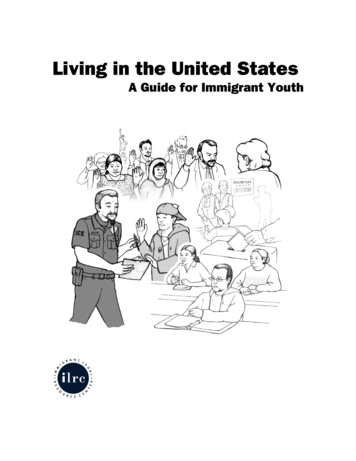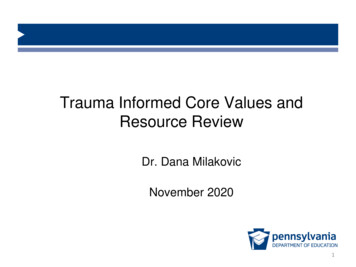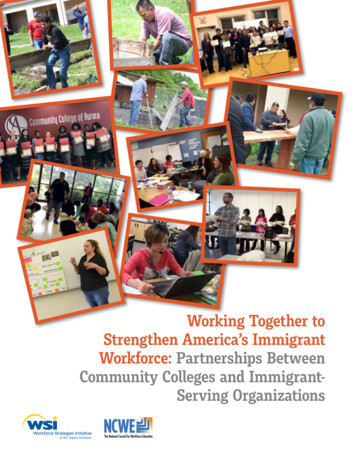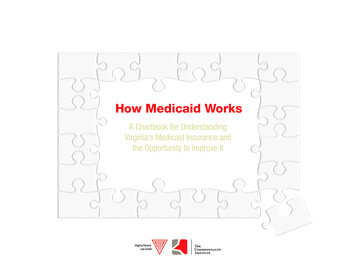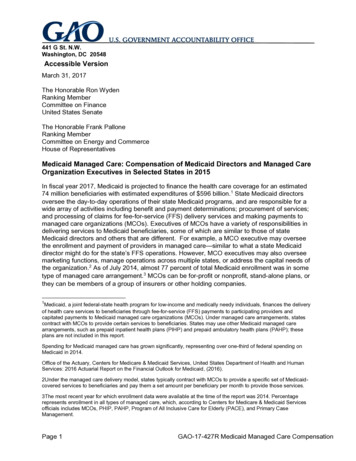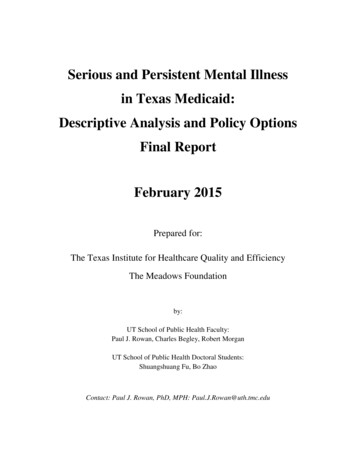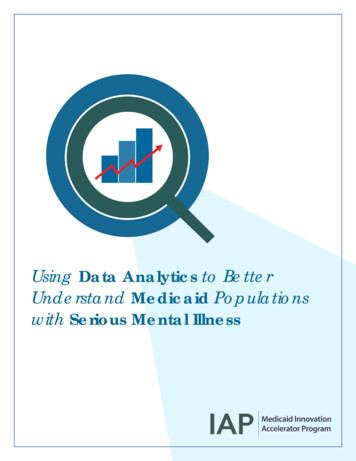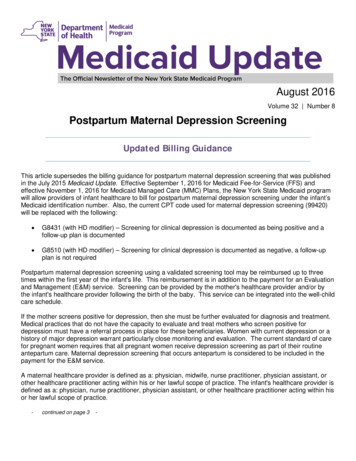
Transcription
A Data ProfileJUNE 2022BY VALERIE LACARTEExecutive SummaryPoor health in childhood can have lifelong implications, having been linked to poorer health andhigher medical costs in adulthood. Many immigrantchildren in the United States face additional hurdlesto staying healthy, including a higher likelihood ofbeing in a low-income household and a federal lawthat limits their access to comprehensive healthinsurance. In 2019, close to 2.3 million foreign-bornchildren ages 0 to 18 met the income-based eligibility requirements for Medicaid and the Children’sHealth Insurance Program (CHIP), but 646,000of these children were uninsured. An estimated909,000 of the 2.3 million income-eligible immigrantchildren—40 percent—were barred from accessingMedicaid or CHIP due to their immigration status(unauthorized immigrants, lawful permanent residents with fewer than five years in that status, andcertain other lawfully present immigrants). Theseincome-eligible children with immigration statusesthat made them federally ineligible for these programs had an uninsured rate of 43 percent—morethan seven times the rate among U.S.-born children(6 percent). Even those income-eligible immigrantchildren who were not barred from these federalprograms had a relatively high uninsured rate of18 percent. Higher poverty rates and lower privatecoverage from parents’ employers and other sourceslikely also contributed to these higher uninsuredrates among immigrant children.While federal rules under the 1996 Personal Responsibility and Work Opportunity Reconciliation Act(PRWORA) bar many noncitizen children from publichealth insurance, some states have filled the gapby adopting a federal option to extend coverage toadditional groups, by using state funding, or both.In 2009, through the Children’s Health Insurance Program Reauthorization Act (CHIPRA), Congress authorized states to use federal funds to cover Medicaidand CHIP for a greater range of lawfully present immigrant children. It is up to states to decide whetherto take this option. To date, 34 states and the Districtof Columbia have done so. As of June 2022, the District of Columbia and six states—California, Illinois,Massachusetts, New York, Oregon, and Washington—had gone further by enacting state-fundedprograms to cover unauthorized immigrant children.Four other states (Connecticut, Maine, New Jersey,and Vermont) have adopted legislation that willsoon cover certain groups of unauthorized immigrant children.An estimated 909,000 of the 2.3million income-eligible immigrantchildren—40 percent—were barredfrom accessing Medicaid or CHIP dueto their immigration status.POLICY BRIEFImmigrant Children’s Medicaid andCHIP Access and Participation
IMMIGRANT CHILDREN’S MEDICAID AND CHIP ACCESS AND PARTICIPATIONYet even when immigrant children are eligible forMedicaid and CHIP on both income and immigration-status grounds, they are less likely than U.S.born children in families with similar incomes to participate in these programs. As of 2019, 74 percent offederally eligible immigrant children were enrolledversus 92 percent of U.S.-born children. This heldtrue within all racial and ethnic categories. The largest immigrant–native gap in Medicaid and CHIP coverage was among Latino children, with a participation rate of 92 percent for U.S.-born Latino childrencompared to 64 percent for federally eligible Latinoimmigrant children.The CHIPRA option has been effective in improving the coverage of immigrant children, both byexpanding their eligibility and by encouraging participation among those who are eligible. In 2019, 64percent of income-eligible immigrant children livingin CHIPRA states were federally eligible (this includesall lawfully residing children), versus 35 percent ofthose in non-CHIPRA states. The participation rateof federally eligible immigrant children was 74 percent in CHIPRA states compared to 68 percent innon-CHIPRA states. The four states with the highestparticipation rates for federally eligible immigrantchildren were all CHIPRA states: Massachusetts, NewYork, Michigan, and Washington.The data analyzed in this brief reflect the state ofimmigrant children’s eligibility and coverage in 2019,before the Biden administration and the COVID-19pandemic began. Subsequent policy changes, including a shift in enforcement priorities resulting ina drop in immigrant arrests and the termination ofthe public-charge rule that created immigration consequences for noncitizens who participated (or weredeemed likely to participate) in an expanded list ofpublic benefits programs may have eased concernsin some immigrant families about enrolling their eligible children in Medicaid and CHIP. Meanwhile, thepandemic has greatly increased the need for healthcoverage while reducing private coverage in families where adults have lost their jobs. Despite thesechanges, hundreds of thousands of children remainbarred from public health coverage due to their immigration status, with many in mixed-status familiesthat hesitate to participate in government programs.Gaps in coverage may set back the health and development of immigrant children, leading to potentially reduced quality of life or lower life expectancy,costly medical conditions, and lower productivityduring adulthood.1IntroductionA child’s access to health care can have a long-termimpact, with poor health in childhood linked tohealth complications and higher medical costs inadulthood. Many immigrant children, who are morelikely than their U.S.-born peers to live in low-income households, face additional hurdles to stayinghealthy because federal law limits their access tocomprehensive public health insurance.1The Children’s Health Insurance Program (CHIP) wascreated through the Balanced Budget Act of 1997 andexpanded by the Affordable Care Act of 2010 (ACA).2As a complement to Medicaid, CHIP provides healthcare coverage to uninsured children under age 19whose families’ income is above Medicaid maximumincome limits but below a certain percentage ofthe federal poverty level (FPL), as determined bytheir state of residence.3 States have flexibility in theway they administer Medicaid and CHIP funds and,more importantly, in setting income requirements,thereby increasing or decreasing the number oflow-income children eligible for Medicaid and CHIP.4Foreign-born children may face additional federal eligibility restrictions depending on their immigrationstatus, as a result of the 1996 Personal Responsibilityand Work Opportunity Reconciliation Act (PRWORA).5PRWORA introduced multiple restrictions on noncitizens’ eligibility for a broad range of public benefits,including Medicaid and extended to CHIP when itwas enacted in 1997.6 Under PRWORA, certain non-MIGRATION POLICY INSTITUTE 2
IMMIGRANT CHILDREN’S MEDICAID AND CHIP ACCESS AND PARTICIPATIONcitizens are totally ineligible for federally fundednonemergency Medicaid and CHIP, including allimmigrants without lawful status, many with temporary status, and most lawful permanent residents(LPRs, also known as green-card holders) duringtheir first five years in that status. There are someexceptions to these bars, including for refugees,asylees, and some immigrants with other, mostly humanitarian statuses (see Table 1).TABLE 1Noncitizen Children’s Eligibility for Medicaid and the Children’s Health Insurance ProgramEligible without aFive-Year BarEligible but Subject toFive-Year Bar Refugees Asylees Cuban/Haitian entrants Amerasians Victims of trafficking Iraqi or Afghan Special Immigrant Visa (SIV) holders Withholding of removal grantees Veterans; active duty military members; and theirspouses, unremarried surviving spouses, and childrenIneligible ImmigrantsUnless eligible under the Children’sHealth Insurance ProgramReauthorization Act (CHIPRA) Certain LPRs who areunder age 21 and/orpregnant, if state didnot elect the CHIPRAoption** Unauthorized immigrants Parolees, if paroledinto the United Statesfor one year or longerEligible in CHIPRA states: Certain domesticviolence survivors,including ViolenceAgainst Women Act(VAWA) self-petitioners Nonimmigrant visa holders,including U-visa holders*** Children and youth up to age 21 who are lawfullyresiding in the United States, if state elected CHIPRAoption Supplemental Security Income (SSI) recipients Citizens of Palau, Micronesia, and the Marshall Islandswho lawfully reside in the United States under theCompacts of Free Association (COFA)* Pregnant people who are lawfully residing in theUnited States, if state elected the CHIPRA option Deferred Action for ChildhoodArrivals (DACA) beneficiaries Others granted deferred action Temporary Protected Status (TPS)beneficiaries Certain asylum seekers Certain holders of employmentbased and student temporaryvisas Other lawfully residingindividuals listed in Title 45 ofthe Code of Federal Regulations,Section 152.2 Afghan parolees paroled into the United Statesthrough Operation Allies Welcome* Entrants under COFA are permitted to study, reside, and work in the United States indefinitely, but are not LPRs.** The five-year bar does not apply to LPRs who adjusted status from an exempt group such as refugees and asylees.*** The U nonimmigrant status (U visa) is for victims of certain crimes who are helpful to law enforcement or government officials in theinvestigation or prosecution of criminal activity.Sources: U.S. Citizenship and Immigration Services (USCIS), “Derivative Refugee/Asylum Status for Your Children,” updated July 9, 2020;Karina Fortuny and Ajay Chaudry, “Overview of Immigrants’ Eligibility for SNAP, TANF, Medicaid, and CHIP” (issue brief, U.S. Departmentof Health and Human Services, Office of the Assistant Secretary for Planning and Evaluation, Washington, DC, March 2012), 9–10; EmilyMcCabe and Leslye E. Orloff, “Comparison Chart of VAWA and U Visa Immigrant Relief” (chart, National Immigrant Women’s AdvocacyProject, American University, Washington College of Law, June 20, 2014); USCIS, “Victims of Criminal Activity: U NonimmigrantStatus,” updated June 12, 2018; Claire R. Thomas and Ernie Collette, “Barring Survivors of Domestic Violence from Food Security: TheUnintended Consequences of 1996 Welfare and Immigration Reform,” Drexel Law Review 9 (2017): 379–380; Centers for Medicare andMedicaid Services, “Medicaid and CHIP Coverage of ‘Lawfully Residing’ Children and Pregnant Women” (state health official letter no.10–006, July 1, 2010). For a full list of lawfully residing individuals, see 45 Code of Federal Regulations §152.2.MIGRATION POLICY INSTITUTE 3
IMMIGRANT CHILDREN’S MEDICAID AND CHIP ACCESS AND PARTICIPATIONThis policy brief examines federal eligibility for andparticipation in Medicaid and CHIP by foreign-bornchildren ages 0 to 18. It follows a similar MigrationPolicy Institute publication focused on Medicaid eligibility and participation among immigrant adultsages 19 to 64.7 This analysis presents estimates ofthe number of immigrant children who have incomes low enough to qualify for Medicaid and CHIP,and among them, the number who are either federally eligible or ineligible due to their immigrationstatus under the categories set out in PRWORA. Thebrief also describes Medicaid and CHIP participationand uninsured rates among U.S.-born and federallyeligible immigrant children at the national and statelevels and by their race and ethnicity.CHIPRA Option and StateDiscretionCHIP was initially enacted for a limited time buthas been incrementally extended since 2009, withCongress most recently reauthorizing the programthrough January 2028.8 When reauthorizing CHIP inthe Children’s Health Insurance Program Reauthorization Act of 2009 (CHIPRA), Congress allowed statesto extend coverage to certain green-card holdersduring the time when they would otherwise face thefive-year bar, and to certain other lawfully presentimmigrants: Medicaid coverage for those who arepregnant, CHIP for children and youth up to age 19,and Medicaid for those up to age 21.9Lawfully residing immigrants who are not federallyeligible for Medicaid and CHIP can become eligiblewhen a state opts to extend coverage under CHIPRA.In states that take this CHIPRA option, these immigrants include LPRs during their first five years inthat status, persons with temporary statuses (such asTemporary Protected Status and Deferred EnforcedDeparture), and certain asylum seekers, but not unauthorized immigrants and persons granted reliefunder the Deferred Action for Childhood Arrivals(DACA) program. As of June 2022, 34 states and theDistrict of Columbia had extended Medicaid andCHIP coverage to lawfully residing children withoutthe five-year wait.10Federal dollars cannot be used to fund coveragefor unauthorized immigrant populations. However,the District of Columbia and six states—California, Illinois, Massachusetts, New York, Oregon, andWashington—administer and fund their own programs without federal support (see Box 1) to coverincome-eligible unauthorized immigrant children(in addition, Washington, DC covers unauthorizedimmigrant adults of all ages, and California coversyoung unauthorized immigrant adults ages 19 to 25and, since May 1, 2022, also covers adults ages 50 to64).11The District of Columbia andsix states—California, Illinois,Massachusetts, New York, Oregon, andWashington—administer and fundtheir own programs without federalsupport . to cover income-eligibleunauthorized immigrant children.MIGRATION POLICY INSTITUTE 4
IMMIGRANT CHILDREN’S MEDICAID AND CHIP ACCESS AND PARTICIPATIONBOX 1State Replacement Programs Extending Medicaid- and CHIP-Equivalent Coverage to Income-EligibleUnauthorized Immigrant ChildrenAs of June 2022, the District of Columbia and six states had gone beyond simply taking the CHIPRA optionwith measures to ensure that all children have access to comprehensive and affordable health insurance. Byfunding their own Medicaid- and CHIP-equivalent programs, they extend health insurance coverage to allincome-eligible children, including unauthorized immigrant children barred from federally funded Medicaidand CHIP. In California, income-eligible children under age 19 are eligible for full-scope Medi-Cal and so areyoung adults between ages 19 and 25, though their maximum family income threshold is lower thanthat of children (138 percent compared to 266 percent of the FPL). In the District of Columbia, the Immigrant Children’s Health Program provides health-care coverageto all children below the age of 21 with a family income below 200 percent of the FPL. In Illinois, the state-funded program All Kids provides free or affordable health-care coverage tochildren up to age 18 with a family income below 300 percent of the FPL. In Massachusetts, the Children’s Medical Security Plan provides coverage for primary and preventivemedical and dental services to uninsured children who do not qualify for any other type of MassHealthcoverage. In New York, income-eligible unauthorized immigrant children are eligible for Child Health Plus B. In Oregon, the Oregon Health Plan (Cover All Kids) is open to all income-eligible children under age19, regardless of immigration status. In Washington, state-funded Apple Health for Kids covers all children whose immigration statusmakes them ineligible for federal medical coverage.While they have yet to be implemented, state-funded replacement programs in Connecticut, Maine, NewJersey, and Vermont will soon extend coverage to some unauthorized immigrant children in those states.Other states extend coverage to certain federally ineligible populations—for example in Minnesota,state-funded MinnesotaCare is available for DACA recipients—but they are not as inclusive of all immigrantchildren as the programs described above.Sources: For California: SB 75 covers children of any immigration status under 19, providing full Medi-Cal coverage; see State ofCalifornia, “SB-75 Health,” June 24, 2015. SB 104 provides full coverage for adults ages 19–25 inclusive, providing full Medi-Cal coverage;see State of California, “SB-104 Health,” July 9, 2019. For Washington, DC: District of Columbia, “District of Columbia Medical AssistanceProgram,” Code of the District of Columbia §1-307.02.02, May 18, 2020. For Illinois: Illinois Department of Healthcare and FamilyServices, “About All Kids,” accessed June 17, 2021. Co-pays and premiums may be required based on income. Illinois General Assembly,Covering All Kids Health Insurance Act, 215 ILCS 170/63, effective July 1, 2006. For Massachusetts: State of Massachusetts, “Children’sMedical Security Plan (CMSP),” 130 Mass. Reg. 522.004. Legislation establishing the plan was passed in 1993. For New York: New YorkGovernment, “Documentation Guide. Immigrant Eligibility for Health Coverage in New York State” (guidance document, 2004). ForOregon: Oregon Senate, Relating to Improving the Health of Oregon Children; and Declaring an Emergency, Senate Bill 558 (2017), Chapter652. For Washington: Washington State Healthcare Authority, “Washington Apple Health” (fact sheet, 2022); Washington LawHelp,“Apple Health for Kids Program: Responding to DSHS Requests for Immigration and Citizenship Documents,” updated April 11, 2019;Washington State Legislature, All Kids Bill, Senate Bill 5093, signed March 2007. For Minnesota: Minnesota House Research, “Eligibilityof Noncitizens for Health Care and Cash Assistance Programs” (brief, November 2019); Minnesota Department of Human Services,“Minnesota Health Care Programs Eligibility Policy Manual,” Section 2.5.2 and Section 3.2.1.2, published June 1, 2020. See also NationalImmigration Law Center, “Table 3: Medical Assistance Programs for Immigrants in Various States,” updated July 2021.MIGRATION POLICY INSTITUTE 5
IMMIGRANT CHILDREN’S MEDICAID AND CHIP ACCESS AND PARTICIPATION2Federal Eligibilityof Income-EligibleChildrenBased on analysis of data from the U.S. CensusBureau’s American Community Survey (ACS), theMigration Policy Institute estimates that close to2.3 million foreign-born children ages 0 to 18 wereincome eligible for Medicaid and CHIP in 2019 basedon the maximum family income thresholds set bytheir states of residence (see Box 2 for definitions ofincome and federal eligibility). Approximately 1.4million (60 percent) of these children held an immigration status that made them eligible for Medicaidand CHIP (see Figure 1). The other 40 percent, about909,000 income-eligible immigrant children, wereineligible for federally funded Medicaid and CHIPdue to their immigration status.Of the immigrant children who were federally eligible for Medicaid or CHIP, about half, or 711,000, wereparticipating in these programs. Another424,000 held some other form of health insurance,mostly private coverage through their parents’ employers. For these children, health coverage dependson the quality and stability of their parents’ employment. Yet as the pandemic has illustrated, low-income immigrants are disproportionately employedin industries that are vulnerable to economic fluctuations, and therefore are also vulnerable to loss ofinsurance coverage.12 Finally, an estimated 252,000immigrant children who were federally eligible forMedicaid and CHIP were uninsured (see Section 4 forfurther information on uninsured children).FIGURE 1Estimated Medicaid and CHIP Income-Eligible Foreign-Born Children (ages 0–18), by FederalImmigration-Status Eligibility and Participation, United States, 2019Participating inMedicaid or CHIP711,000Federally Ineligible909,000Federally Eligible1,373,000No Medicaid or CHIP,Holding Other Insurance424,000No Medicaid or CHIP,Uninsured, 252,000Note: Numbers may not add up to the total due to rounding. The federally eligible population includes all lawfully residing childrenin states that adopted the CHIPRA option (see Table 1 and Box 2 for definitions of federally eligible and ineligible children). Otherinsurance includes public coverage other than Medicaid, Department of Veterans Affairs insurance, and private insurance. Based onU.S. Census Bureau definitions, private insurance can include employer-sponsored coverage, plans purchased by individuals fromprivate insurance companies, TRICARE, or other military health-care coverage.Source: These 2019 data result from Migration Policy Institute (MPI) analysis of data from the 2015–19 American Community Survey(ACS), pooled, and the 2008 Survey of Income and Program Participation (SIPP), weighted to 2019 unauthorized immigrant populationestimates provided by Jennifer Van Hook at The Pennsylvania State University.MIGRATION POLICY INSTITUTE 6
IMMIGRANT CHILDREN’S MEDICAID AND CHIP ACCESS AND PARTICIPATIONBOX 2Determination of Income Eligibility and Federal EligibilityWhile many studies on immigrants’ use of public benefits focus on contrasts between immigrant and native-born participation, this brief goes a step further using a set of techniques to disaggregate outcomes byimmigrants’ federal eligibility status. To determine if a child ages 0 to 18 is income eligible for Medicaid/CHIP,the author uses state-level maximum income limits and income determination rules based on reconstructedfamily units and adjusted gross income, as described in MPI’s 2021 policy brief Medicaid Access and Participation: A Data Profile of Eligible and Ineligible Immigrant Adults.To impute immigration status and identify federally eligible and ineligible immigrants under PRWORA, theauthor used data from the 2015–19 American Community Survey (ACS), pooled, and the 2008 Survey of Income and Program Participation (SIPP). The methodology used allows for the identification of the most important immigration statuses described in Table 1: lawful permanent residents (with and without five yearsof U.S. residence), nonimmigrants, unauthorized immigrants, refugees, asylees, and Cuban/Haitian entrants.Other smaller categories cannot be captured.Which immigration statuses fall under the definition of “federally eligible” vary depending on whether astate has elected the CHIPRA option. In states that have adopted CHIPRA, all lawfully present foreign-bornchildren ages 0 to 18 are considered to have a status that makes them federally eligible. In states that havenot adopted CHIPRA, federally eligible children include: naturalized citizens, LPRs with more than five yearsof residence, refugees, and those with other, similar humanitarian statuses. The federally ineligible immigrant population includes unauthorized immigrant children (as well as those with DACA) in all states, andin states that have not adopted CHIPRA, it includes nonrefugee LPRs with fewer than five years of U.S. residence and nonrefugee holders of nonimmigrant visas.One challenging aspect of this type of analysis is estimating the number and participation rate of children inquasi-legal immigration statuses, such as TPS holders, who are eligible for Medicaid and CHIP in states thathave adopted CHIPRA. In this analysis, these children appear within the federally ineligible population andtheir participation rate could not be estimated. Though a share of these children were likely income eligibleand living in a state that gave them access to federally funded Medicaid and CHIP through CHIPRA, thesenumbers are unlikely to change the general trends found in this analysis.Sources: For a discussion of the methodology to determine eligibility based on income and on immigration status, see Box 1 of ValerieLacarte, Mark Greenberg, and Randy Capps, Medicaid Access and Participation: A Data Profile of Eligible and Ineligible Immigrant Adults(Washington, DC: MPI, 2021). For information on the state maximum income thresholds to access Medicaid/CHIP, see Kaiser FamilyFoundation, “Medicaid and CHIP Income Eligibility Limits for Children as a Percent of the Federal Poverty Level,” accessed March 17,2022.MIGRATION POLICY INSTITUTE 7
IMMIGRANT CHILDREN’S MEDICAID AND CHIP ACCESS AND PARTICIPATIONFIGURE 2Shares of Medicaid and CHIP Income-Eligible Foreign-Born Children (ages 0–18) Who Were FederallyEligible and Ineligible, by Race and Ethnicity, United States, 2019LatinoAsian47%53%73%27%White77%23%Multiracial or Other Race77%23%Black78%22%Federally Eligible ImmigrantsFederally Ineligible ImmigrantsNotes: In this figure all racial/ethnic categories are mutually exclusive, and all Latinos are included in that category regardless of theirrace. “Multiracial or other race” includes respondents who self-identified with more than one race or selected another race not listedin the ACS. Native Americans are excluded from this analysis due to small sample size. The federally eligible population includes alllawfully residing children in states that adopted the CHIPRA option (see Table 1 and Box 2 for definitions of federally eligible andineligible children).Source: These 2019 data result from MPI analysis of data from the 2015–19 ACS, pooled, and the 2008 SIPP, weighted to 2019unauthorized immigrant population estimates provided by Van Hook.A.Race and Ethnicity of IncomeEligible Immigrant ChildrenMore than half of the 2.3 million income-eligibleimmigrant children in 2019 were Latino (of any race),representing 1.2 million children ages 0 to 18. Asianchildren comprised the second largest racial/ethnicgroup, representing 20 percent of all income-eligibleforeign-born children (466,000 children). Black andWhite immigrant children represented 12 percentand 11 percent of all income-eligible immigrant children, respectively.13 The top ten countries of originfor income-eligible immigrant children were: Mexico, El Salvador, Guatemala, China, Honduras, the Dominican Republic, the Philippines, India, Venezuela,and Vietnam.The share of these income-eligible children whowere ineligible for Medicaid and CHIP due to theirimmigration status varied considerably by race andethnicity, with an estimated 53 percent of Latino immigrant children federally ineligible in 2019 (see Figure 2). Their share was twice as high as that for Asian(27 percent), White (23 percent), Multiracial or otherrace (23 percent), and Black (22 percent) income-eligible immigrant children.B.State-by-State Estimates ofIncome-Eligible ImmigrantChildrenIn 2019, the number and share of foreign-born children who were income eligible for Medicaid andCHIP varied by state, as did the share who wereeligible for federally funded coverage under theseprograms based on their immigration statuses (seeTable 2). Notable trends include: About 88 percent of income-eligibleimmigrant children lived in one of theMIGRATION POLICY INSTITUTE 8
IMMIGRANT CHILDREN’S MEDICAID AND CHIP ACCESS AND PARTICIPATION34 states or the District of Columbia thatchose to expand eligibility for public healthinsurance by adopting the CHIPRA option.On average, 64 percent of income-eligibleimmigrant children in CHIPRA states werefederally eligible for Medicaid and CHIP basedon their immigration status, compared to only35 percent in non-CHIPRA states. In states that adopted the CHIPRA option,an estimated 40 percent of federally eligibleimmigrant children were LPRs with fewerthan five years in that status and 7 percentwere holders of nonimmigrant visas, meaningthat nearly half of federally eligible immigrantchildren in those states were lawfully presentbut would not have had access to coverage iftheir state had not taken the CHIPRA option. The three states with the largest populationsof foreign-born children ages 0 to 18 withincomes low enough to qualify for Medicaidand CHIP were: California, Texas, and NewYork. Although all three of these states haveadopted the CHIPRA option, the sharesof immigrant children who were federallyeligible for Medicaid and CHIP in Californiaand Texas (59 percent and 52 percent,respectively) were significantly lower thanthe share in New York (74 percent). Thisreflects the fact that California and Texas hadamong the highest shares of income-eligibleimmigrant children who were not lawfullypresent in the country (41 percent and 48percent, respectively) compared to 26 percentin New York. The states with the highest shares of federallyeligible immigrant children were: Minnesota,Iowa, Nebraska, Ohio, Wisconsin, New York,Pennsylvania, Massachusetts, and Hawaii.These states had all elected the CHIPRAoption and, compared to other states, theirforeign-born child populations generally hadlower shares of unauthorized immigrants andhigher shares of LPRs with more than fiveyears in that status and other immigrants ingroups eligible for coverage under PRWORA,such as refugees. All except New York alsohad relatively small populations of incomeeligible immigrant children.14 States with the lowest shares of incomeeligible immigrant children who werefederally eligible for Medicaid and CHIP wereall states that have not adopted the CHIPRAoption: Mississippi, Tennessee, Kansas,Alabama, Oklahoma, Georgia, Arizona,and Indiana. In these states, unauthorizedimmigrants made up relatively large shares ofthe income-eligible immigrant population.15MIGRATION POLICY INSTITUTE 9
IMMIGRANT CHILDREN’S MEDICAID AND CHIP ACCESS AND PARTICIPATIONTABLE 2Estimated Medicaid and CHIP Income-Eligible Children (ages 0–18), by Nativity and Federal Eligibility,50 States and District of Columbia, 2019AlabamaIncome-Eligible Foreign-Born ChildrenIncome-EligibleU.S.-Born ChildrenTotalNumberNumberFederally Eligible forMedicaid and CHIPNumberFederally Ineligible forMedicaid and CHIPShare of TotalNumberShare of elaware*101,0005,000----District ,
that limits their access to comprehensive health insurance. In 2019, close to 2.3 million foreign-born children ages 0 to 18 met the income-based eligi-bility requirements for Medicaid and the Children's Health Insurance Program (CHIP), but 646,000 of these children were uninsured. An estimated children—40 percent—were barred from accessing

